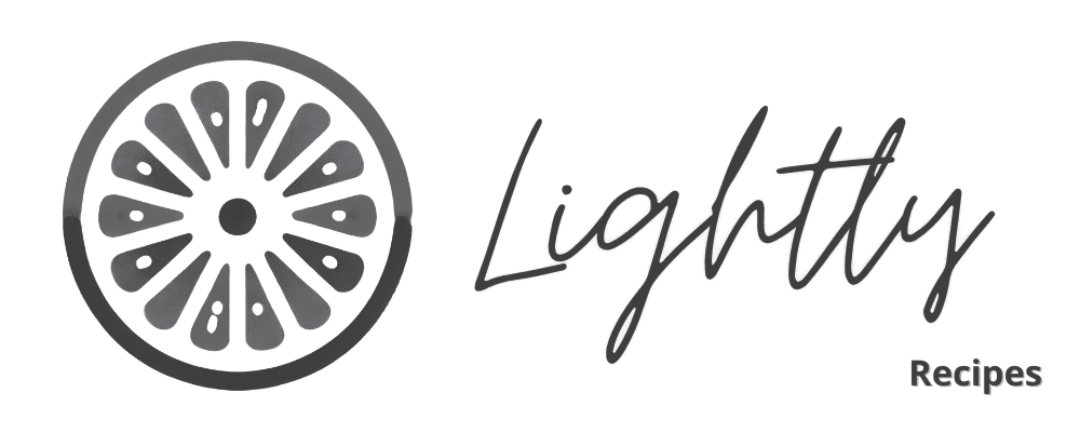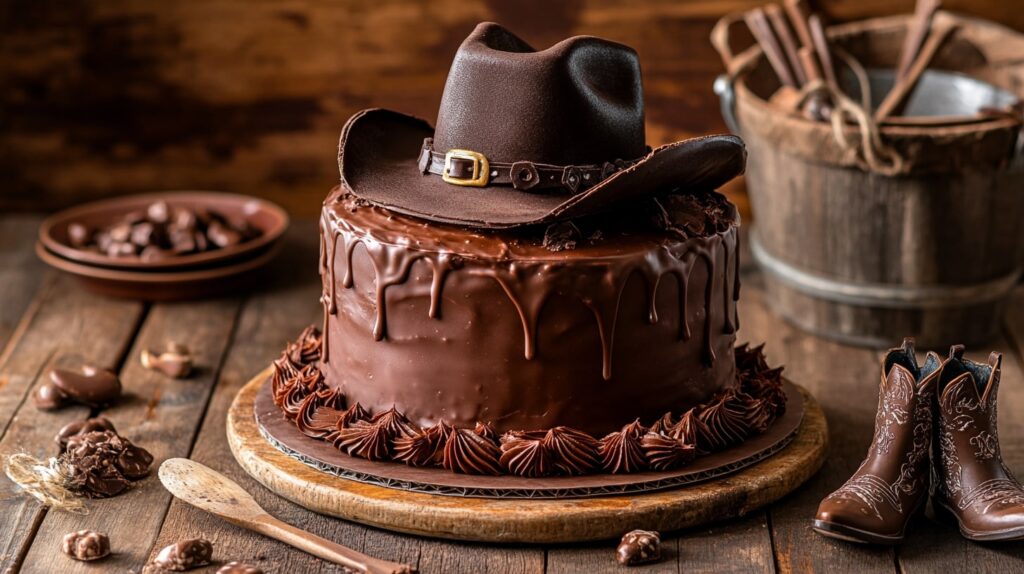
Cowboy cake is a timeless, rustic dessert that captures the essence of the Old West. It is known for its simplicity and rich flavor. This classic cake has roots in cowboy culture, where cooks relied on minimal ingredients to create hearty meals. Whether you’re hosting a western-themed party or craving a nostalgic treat, cowboy cake is the perfect choice.
In this guide, we’ll cover everything you need to know about cowboy cake. From its fascinating history to step-by-step recipes and decorating tips, we’ve got you covered. We’ll also discuss serving ideas, storage methods, and healthier variations. By the end, you’ll be ready to bake a cowboy cake that blends tradition with modern tastes.
Table of contents
What Is Cowboy Cake?
Cowboy cake is a rustic dessert made with pantry staples like flour, sugar, cocoa powder, eggs, and oil. It stands out because of its moist texture and rich flavor. Plus, it can stay fresh for several days—qualities that made it a favorite among cowboys on long journeys.
Originally, cowboy cakes were baked in Dutch ovens over open flames. Despite their simplicity, they provided a satisfying treat after a long day on the trail. Today, modern versions include chocolate, nuts, dried fruits, or spices, making it a versatile dessert for any occasion.
A Brief History of Cowboy Cake
Cowboy cake traces its origins to the 19th century. During this era, cowboys spent long days herding cattle and relied on chuckwagons for meals. Desserts like cowboy cake became staples because they were easy to prepare and used non-perishable ingredients.
The cake also provided much-needed energy after long days of hard work. It symbolized resilience and creativity, as early bakers had to make do with limited resources. Over time, it evolved into a beloved dessert that still evokes the spirit of the Wild West.
Cowboy Culture and Food Traditions
Cowboys played a central role in shaping the culinary traditions of the American West. As cattle herders, they spent weeks or even months on the open plains, surviving on meals prepared from limited supplies carried in chuckwagons. These mobile kitchens provided basic staples such as flour, sugar, baking soda, and dried fruits.
Meals had to be filling, durable, and easy to prepare over an open fire. Desserts, like cowboy cake, were often baked in cast-iron Dutch ovens. These cakes relied on non-perishable ingredients, which made them ideal for long journeys. In addition, cowboy cakes required no refrigeration, a feature that was critical for life on the trail.
Because cowboy culture emphasized practicality, recipes like cowboy cake reflected this mindset. The cakes were simple yet satisfying, often flavored with cocoa or molasses to add richness. Over time, this humble dessert became symbolic of Western hospitality and resourcefulness.
How Cowboy Cake Became a Staple Dessert
Cowboy cake rose in popularity during the late 1800s. During cattle drives, cooks known as “cookie men” were responsible for feeding the crew. Their creativity turned simple ingredients into flavorful dishes that sustained cowboys through long workdays.
The cake itself became a favorite because it could be prepared quickly. It didn’t require fresh milk or butter, which were hard to come by on the trail. Instead, ingredients like vegetable oil and dried fruits offered long shelf lives without sacrificing flavor.
As settlers moved west, cowboy cake transitioned from campfire cooking to homestead kitchens. It became a centerpiece at gatherings, celebrations, and special events. In fact, its rustic appeal made it popular in rural communities and family traditions.
Even today, cowboy cake remains a symbol of Western heritage. Modern recipes have adapted it to contemporary tastes, but its roots as a trail-ready dessert are still honored.
Symbolism in Western Culture
Beyond its culinary appeal, cowboy cake represents resilience and survival. It mirrors the lifestyle of cowboys who faced harsh conditions but still found ways to celebrate life’s simple pleasures.
In Western folklore, cowboy cake embodies the spirit of adventure, freedom, and self-reliance. It has also gained popularity as a themed dessert for rodeos, weddings, and western-inspired events. Its rustic look and rich flavor make it a favorite centerpiece for celebrations.
Key Ingredients for Cowboy Cake
Cowboy cake is beloved for its simplicity and rich flavor. It uses basic pantry staples, making it easy to prepare without a trip to the store. Here’s a breakdown of the essential ingredients you’ll need:
Core Ingredients for Flavor and Texture
- Flour – The foundation of the cake, providing structure and stability.
- Sugar – Adds sweetness and moisture, ensuring the cake stays soft.
- Cocoa Powder – Gives a rich chocolate flavor, though some variations skip it for a vanilla base.
- Baking Soda – Helps the cake rise and creates a light texture.
- Salt – Balances sweetness and enhances flavors.
- Eggs – Binds the ingredients and adds moisture.
- Oil or Butter – Provides richness and keeps the cake moist.
- Water or Coffee – Adds liquid for mixing while enhancing flavor. Coffee can deepen the chocolate flavor.
- Vanilla Extract – Offers a hint of sweetness and aroma.
- Optional Add-Ins – Dried fruits, nuts, and spices can be added for variety and texture.
Essential Baking Tools and Supplies
To prepare your cowboy cake, you’ll need the following tools:
- Mixing Bowls – For combining wet and dry ingredients separately.
- Whisk and Spatula – For smooth mixing and folding ingredients.
- Measuring Cups and Spoons – Ensures accurate measurements for consistent results.
- Cake Pan or Dutch Oven – Cowboy cakes were traditionally baked in Dutch ovens, but modern recipes often use round or square pans.
- Oven or Campfire Setup – Cowboy cakes can be baked in a home oven or outdoors in a Dutch oven over hot coals.
Step-by-Step Cowboy Cake Recipe
Preparation Steps
- Preheat the Oven – Set the oven to 350°F (175°C). If using a Dutch oven outdoors, preheat it with hot coals.
- Prepare the Pan – Grease the cake pan or Dutch oven and line it with parchment paper for easy removal.
- Mix Dry Ingredients – In a large bowl, whisk together the flour, sugar, cocoa powder, baking soda, and salt.
- Combine Wet Ingredients – In another bowl, beat the eggs, add the oil, water (or coffee), and vanilla extract. Stir until smooth.
Baking Instructions
- Combine Wet and Dry Ingredients – Gradually pour the wet mixture into the dry ingredients. Stir until smooth and well combined. Avoid over-mixing to prevent a dense texture.
- Pour Batter into Pan – Transfer the batter to the prepared pan or Dutch oven. Smooth the top with a spatula.
- Bake – Bake for 30–35 minutes in a home oven. If using a Dutch oven outdoors, bake for 40–45 minutes, rotating it occasionally for even heat.
- Check for Doneness – Insert a toothpick into the center. If it comes out clean, the cake is ready.
Cooling and Serving Tips
- Cool the Cake – Allow the cake to cool in the pan for 10–15 minutes before transferring it to a wire rack.
- Serve – Slice and serve plain, or add frosting, whipped cream, or fruit toppings for extra flair.
Flavor Variations of Cowboy Cake
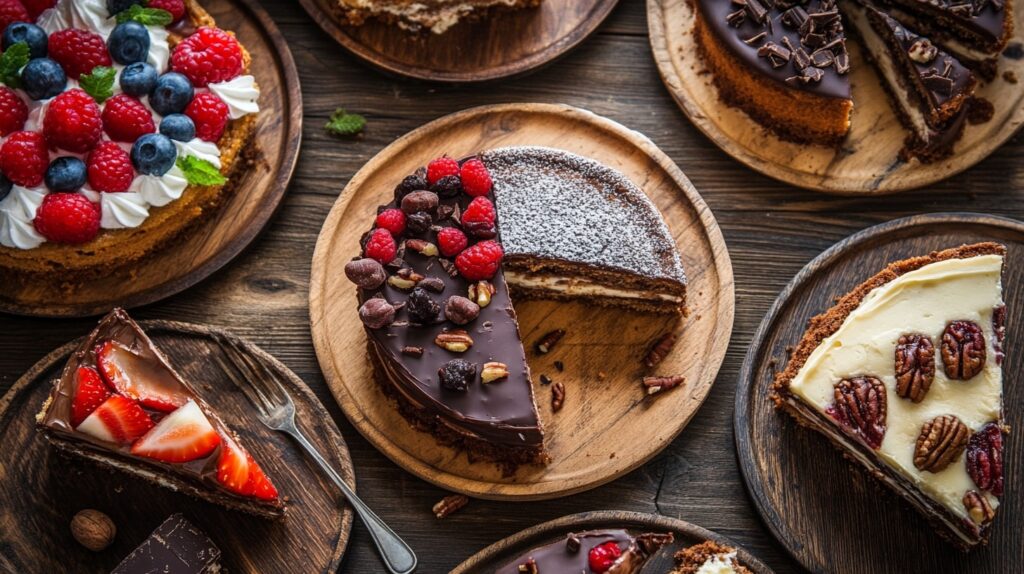
One of the best features of cowboy cake is its adaptability. Whether you prefer a classic taste or want to experiment with flavors, there’s a variation for every palate.
Classic Chocolate Cowboy Cake
- The traditional recipe features cocoa powder for a rich, chocolatey flavor.
- To enhance the chocolate taste, add a splash of brewed coffee to the batter.
- Top it with chocolate ganache or a dusting of powdered sugar for a simple finish.
Fruity Cowboy Cake Variations
- Apple and Cinnamon – Add diced apples and a pinch of cinnamon for a warm, comforting flavor.
- Raisin and Walnut – Incorporate raisins and chopped walnuts for added texture and natural sweetness.
- Berry Blast – Mix in dried cranberries, blueberries, or raspberries for a tangy twist.
Nutty and Spiced Options
- Pecan and Caramel – Add chopped pecans and drizzle caramel sauce over the top for a sweet and nutty flavor.
- Pumpkin Spice Cowboy Cake – Incorporate pumpkin puree and pumpkin pie spice for a fall-inspired dessert.
- Coconut Cowboy Cake – Stir in shredded coconut and top with cream cheese frosting for a tropical feel.
Decorating Ideas for a Cowboy Cake
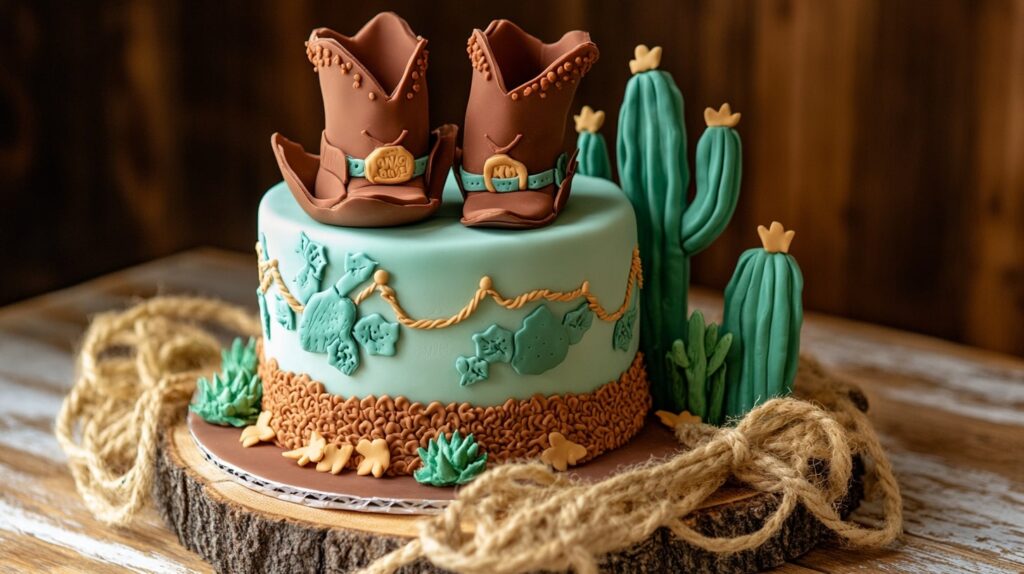
Cowboy cakes are often decorated to match rustic or western-themed events. Here are some creative ideas to elevate your presentation:
Rustic Designs with Edible Toppers
- Use crushed graham crackers to create a dirt-like texture on top.
- Add edible cactus or horseshoe-shaped toppers made from fondant for a western vibe.
- Sprinkle powdered sugar lightly to mimic dust from the plains.
Western-Themed Cake Decorations
- Decorate with miniature cowboy hats, boots, or ropes for a themed centerpiece.
- Incorporate edible gold stars to give it a sheriff’s badge look.
- Place small toy cowboys or horses around the cake for a fun display.
Cowboy Hat and Boot Designs
- Use frosting to draw cowboy hats or boots directly onto the cake.
- Create a layered cake shaped like a cowboy hat using molds or carving techniques.
- Add piped designs with chocolate or colored icing for intricate details.
Serving Suggestions and Pairings
Best Beverages to Serve with Cowboy Cake
- Coffee or Espresso – Complements the chocolatey flavor and adds a bold pairing.
- Milk or Hot Chocolate – Ideal for kids and those who prefer a creamy, sweet drink.
- Spiced Tea or Apple Cider – Provides a warm and comforting contrast, especially in fall and winter.
Side Dishes and Snacks That Complement the Flavor
- Whipped Cream or Ice Cream – Serve with vanilla or cinnamon ice cream for added richness.
- Fresh Fruit – Pair slices of cowboy cake with berries, cherries, or sliced peaches for freshness.
- Candied Nuts – Offer a crunchy topping or side to balance the soft texture of the cake.
Healthier Alternatives for Cowboy Cake
Cowboy cake can be easily adapted to suit different dietary preferences without sacrificing flavor. Here are a few healthier variations:
Low-Sugar and Low-Calorie Options
- Natural Sweeteners – Replace white sugar with honey, maple syrup, or coconut sugar for a more natural sweetness.
- Reduced Sugar – Cut the sugar content by 25-30% without affecting texture. You can also add mashed bananas or unsweetened applesauce to boost sweetness naturally.
- Portion Control – Bake the batter into muffins or cupcakes to create smaller, individual servings.
Gluten-Free Alternatives
- Gluten-Free Flour – Use a gluten-free flour blend instead of all-purpose flour. Ensure the blend contains xanthan gum for proper binding.
- Nut Flours – Almond or coconut flour can provide a denser texture while adding a subtle nutty flavor.
Dairy-Free and Vegan Variations
- Egg Replacements – Substitute eggs with flax eggs (1 tablespoon ground flaxseed + 3 tablespoons water per egg) or unsweetened applesauce.
- Milk Alternatives – Use almond milk, oat milk, or coconut milk instead of dairy milk.
- Vegan Butter or Oils – Swap out butter for plant-based alternatives like coconut oil or avocado oil.
Tips for Perfecting Your Cowboy Cake
Even with its simple ingredients, cowboy cake can be tricky to perfect. Follow these expert tips to achieve the best results:
Common Baking Mistakes to Avoid
- Over-Mixing the Batter – Stir just until the ingredients are combined to avoid a dense or tough cake.
- Incorrect Oven Temperature – Always preheat your oven and use an oven thermometer if necessary. Inconsistent heat can affect texture.
- Skipping Pan Preparation – Grease and line your pan with parchment paper to prevent sticking.
Secrets for a Moist and Fluffy Texture
- Add Applesauce or Yogurt – These ingredients boost moisture without making the cake heavy.
- Don’t Overbake – Start checking for doneness 5 minutes before the recommended time. A toothpick should come out with a few moist crumbs.
- Room Temperature Ingredients – Ensure eggs and liquids are at room temperature to create a smooth, even batter.
Enhancing Flavor
- Infuse Spices – Add cinnamon, nutmeg, or cloves to warm up the flavor profile.
- Layer Flavors – Incorporate vanilla extract, almond extract, or orange zest for depth.
Storing and Preserving Cowboy Cake
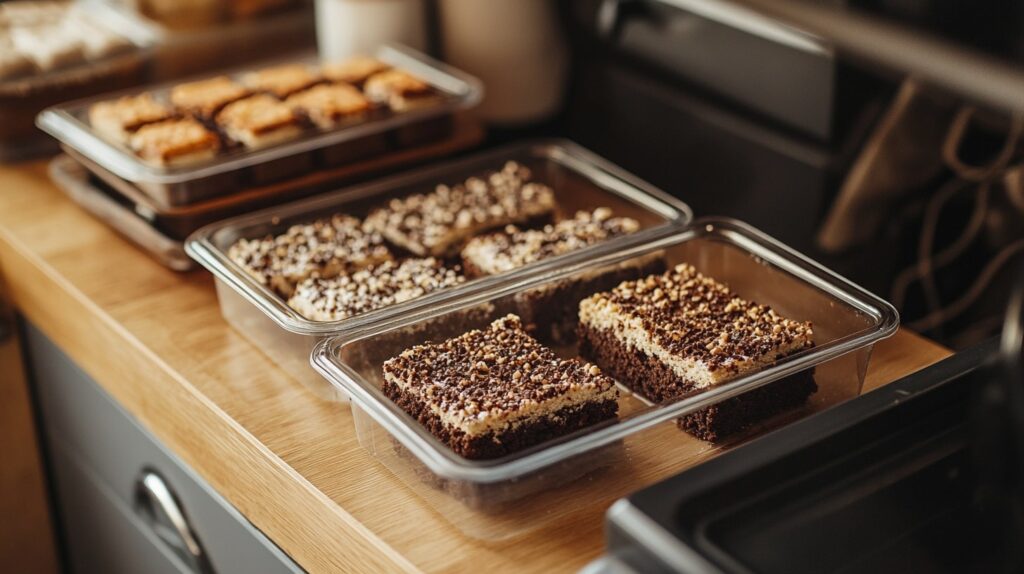
Cowboy cake is known for its long shelf life, but proper storage ensures it stays fresh for even longer.
Short-Term Storage
- Room Temperature – Store the cake in an airtight container at room temperature for up to 3 days.
- Refrigeration – If the cake has frosting, refrigerate it in a sealed container for up to 5 days. Let it sit at room temperature before serving.
Freezing for Long-Term Storage
- Freeze Whole or in Slices – Wrap the cake (or slices) tightly in plastic wrap and place in a freezer-safe bag. Label with the date.
- Thaw Properly – Let the cake thaw at room temperature for several hours or overnight in the fridge. Avoid microwaving, as it can dry out the cake.
Reheating Tips
- Oven Method – Preheat to 300°F (150°C) and warm the cake for 10–15 minutes. Cover it with foil to retain moisture.
- Microwave Method – Heat individual slices for 10–15 seconds, but add a damp paper towel over the cake to prevent drying.
Fun Facts About Cowboy Cake
- Inspired by the Old West – Cowboy cake dates back to the 1800s when cowboys needed durable, portable desserts during long cattle drives.
- Baked in Dutch Ovens – Originally, cowboy cakes were cooked over open flames in cast-iron Dutch ovens, making them a staple in outdoor cooking.
- Minimal Ingredients, Maximum Flavor – The recipe was designed to use shelf-stable ingredients like flour, sugar, and dried fruits, ensuring it could last for days without refrigeration.
- Symbol of Resourcefulness – Cowboy cake represents ingenuity and survival, reflecting the resilience of pioneers and cowboys.
- Modern Popularity – Today, cowboy cakes are often featured in western-themed parties, barbecues, and even cowboy weddings due to their rustic charm.
Frequently Asked Questions (FAQs)
1. How long does it take to bake a cowboy cake?
Cowboy cakes typically bake for 30–35 minutes in a standard oven at 350°F (175°C). If using a Dutch oven outdoors, expect 40–45 minutes with regular rotation for even heat.
2. Can I make a cowboy cake without eggs?
Yes, you can substitute eggs with flax eggs (1 tablespoon ground flaxseed + 3 tablespoons water per egg) or ¼ cup unsweetened applesauce per egg. These alternatives keep the cake moist and vegan-friendly.
3. What icing pairs best with a cowboy cake?
Cowboy cake pairs well with chocolate ganache, cream cheese frosting, or a simple glaze. You can also dust it with powdered sugar for a minimalist look.
4. Can I prepare cowboy cake in advance?
Absolutely! Cowboy cake can be baked 1–2 days in advance and stored at room temperature in an airtight container. It also freezes well for longer storage.
5. Is cowboy cake gluten-free?
Traditional recipes are not gluten-free, but you can substitute all-purpose flour with a gluten-free baking mix or almond flour to make it gluten-free.
6. What makes cowboy cake different from other cakes?
Cowboy cake stands out because it’s simple, durable, and made with pantry staples. Unlike delicate cakes, it stays moist and flavorful for days, making it ideal for travel and outdoor events.
Explore More Delicious Recipes and Cooking Tips!
If you enjoyed learning about cowboy cake, you’ll love exploring more recipes and cooking tips on our site! Whether you’re looking for savory dishes or healthy snacks, we’ve got you covered. Check out these related articles:
- Understanding Beef Tips: A Comprehensive Guide – Learn how to prepare tender and flavorful beef tips for any occasion.
- Stew Meat vs. Beef Tips: Key Differences and Best Recipes – Discover how these cuts differ and find the best recipes for each.
- Rice Cakes: Benefits and Recipes for Healthy Snacking – Try these versatile and healthy snack ideas to complement your meals.
- Cinnamon Sugar Muffins: A Sweet and Simple Treat – Perfect for dessert or breakfast, these muffins pair well with cowboy cake.
Explore these guides to add variety to your kitchen and discover new flavors that match your rustic cowboy cake!
Conclusion
Cowboy cake is more than just a dessert—it’s a symbol of history, tradition, and resourcefulness. Its rustic charm, rich flavor, and adaptability make it a favorite for western-themed celebrations or everyday indulgence.
From its humble origins on cattle drives to its modern variations, cowboy cake has stood the test of time. Whether you prefer the classic chocolate version or experiment with fruity and nutty flavors, this dessert always delivers satisfaction.
By following the tips, recipes, and serving ideas in this guide, you’re now ready to bake your own cowboy cake. Enjoy the process, and don’t be afraid to get creative with decorations and flavor twists!
